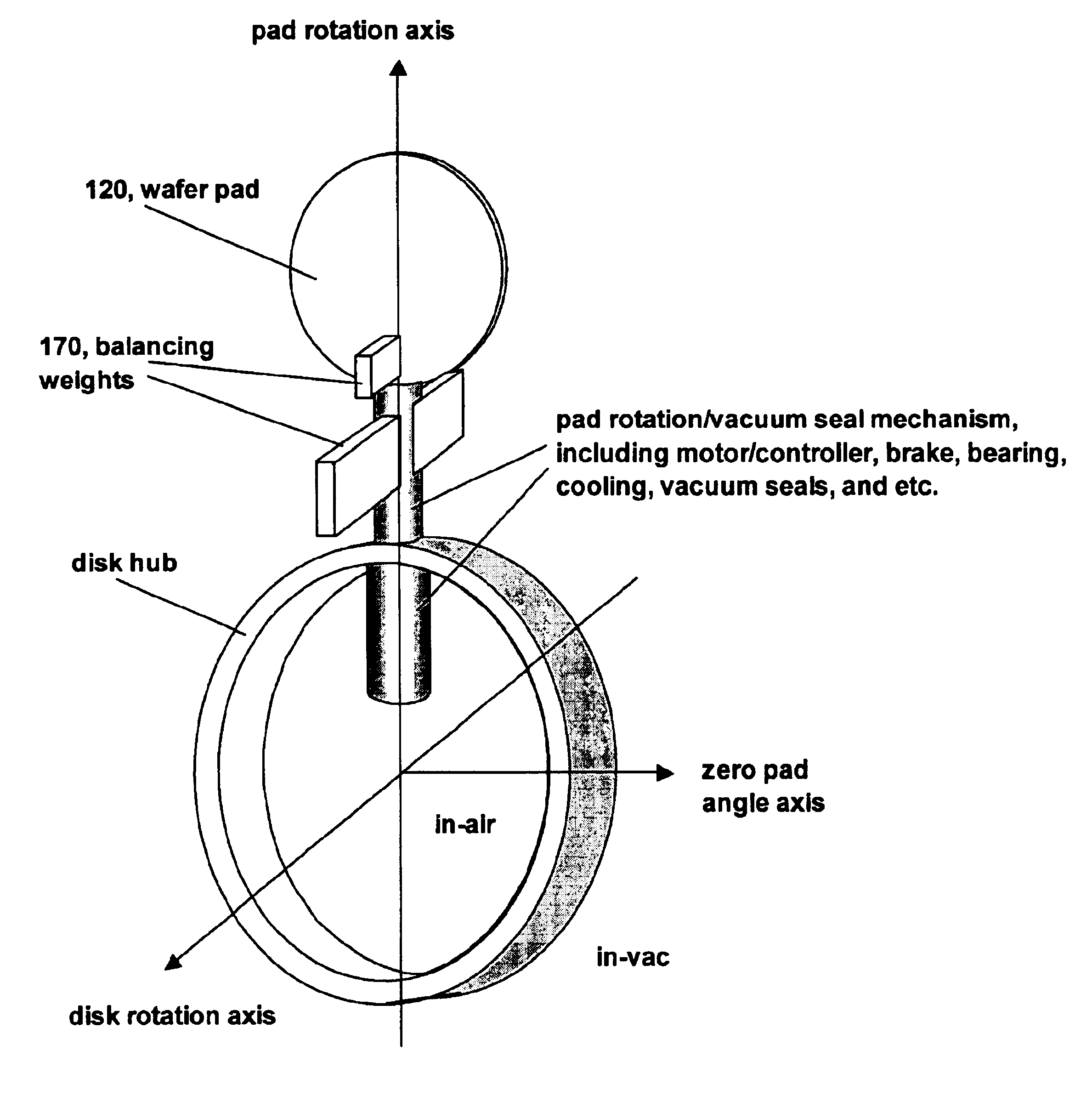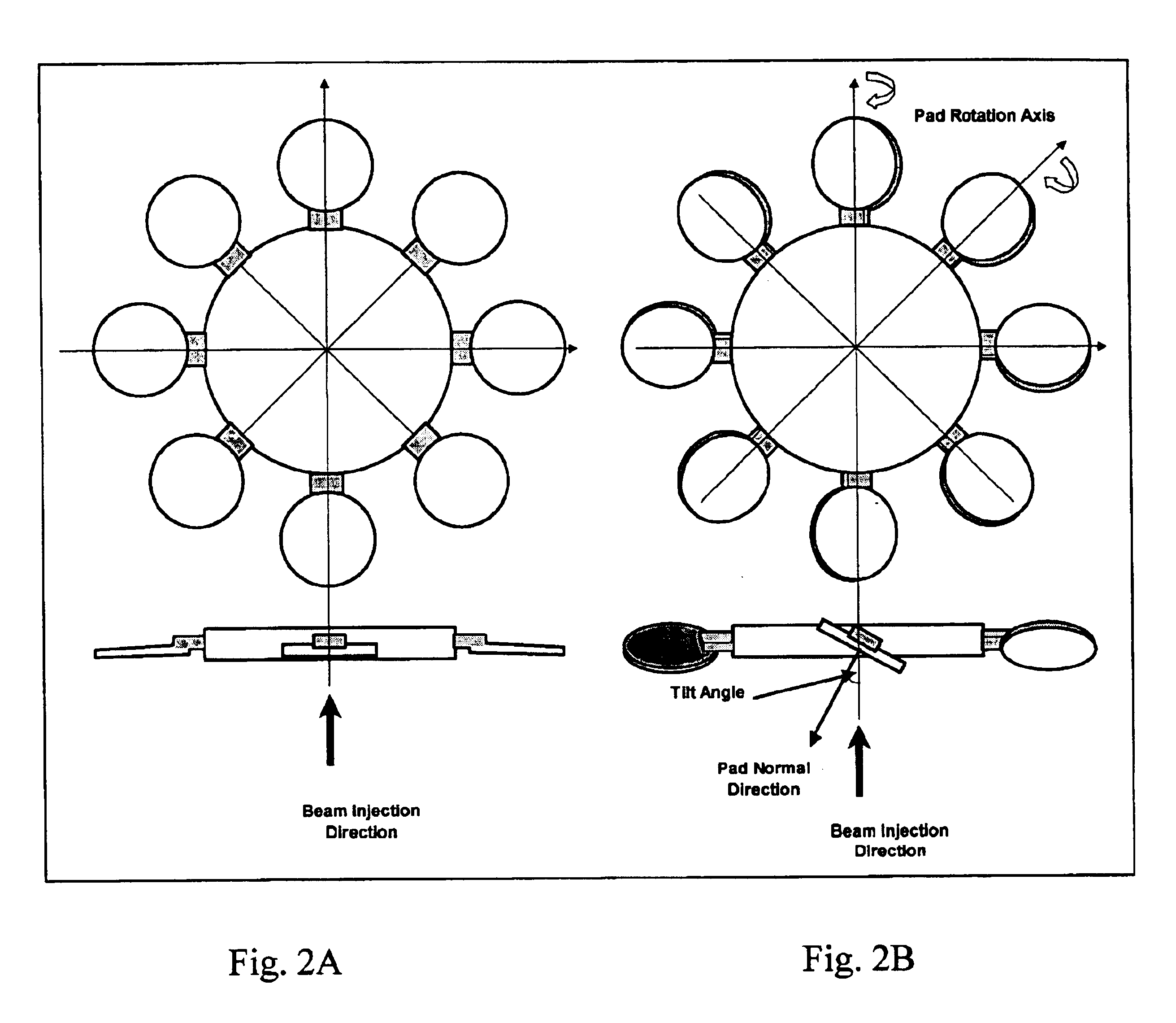Apparatus and method for reducing implant angle variations across a large wafer for a batch disk
a batch disk and ion implantation technology, applied in electrical equipment, nuclear engineering, electric discharge tubes, etc., can solve the problems of batch type ion batch type implanter angle integrity degradation, etc., to minimize the rotation error of the pad, minimize the tilt/twist angle variation, and minimize the effect of rotation error
- Summary
- Abstract
- Description
- Claims
- Application Information
AI Technical Summary
Benefits of technology
Problems solved by technology
Method used
Image
Examples
second embodiment
The first embodiment of present invention is to individually rotate each substrate pad of a batch disk to allow implant angle control. The second embodiment is to counter the centrifugal torque to keep the pad at any desired tilt angle while the disk spins at high speed. The methods to counter the centrifugal torque are
i) add mass 170 to counter balance the pad mass and reduce the total torque on the whole pad assembly as that shown in FIG. 9;
ii) add brake to the rotation mechanism in the pad assembly so that the pad can not rotate due to mechanical friction force or lock-key;
iii) use motor to hold the pad assembly. The sum of the friction torque and the motor holding torque should be larger than the centrifugal torque.
third embodiment
The third embodiment is to prepare a pad surface that has concaved shape to minimize tilt / twist angle variation across a wafer at any desired pad angle or implant tilt angle range. The curvature of the concaved pad surface is conical or near conical with the conical surface line coincide with the pad's pedestal surface line as shown in FIG. 7. Each pad has its own conical surface with the distance between the cone axis and the disk spin axis equal to L. When L=0, the conical surfaces of all pads belong to the same cone, which is the commonly used conical surface for fixed pad disk application and can provide 0 tilt angle variation across a wafer during implant. However, when each pad rotates around its pad rotation axis to give different implant tilt angle, the tilt angle variation increases as the tilt angle as shown in curve #2 of FIG. 6A. By increasing L from 0 to a certain value, this invention enable a person of ordinary skill in the art to move the near-zero tilt angle variati...
fourth embodiment
The fourth embodiment demonstrates a major different technique for shaping a concaved pad surface by forming a pad surface that has concaved shape following the substrate natural bending surface under centrifugal force to maximize contact area between the substrate and the pad surface to increase thermal conductivity. The natural bending surface, as that shown in FIG. 8, should be chosen as close as the desired conical surface to minimize implant angle variation. As emphasized above, using a concaved pad surface similar to the wafer natural bending shape is the optimal way to make sure good thermal contact between wafers and their supporting pads under practical disk spin speed (<1000 rpm).
This invention thus discloses a method to rotate individual pad of a batch disk to an implant angle and lock them in place, with the pad surface having a natural bending concaved surface to minimize the implant angle variation across a wafer on the pad for both tilt angle and twist angle, at large...
PUM
 Login to View More
Login to View More Abstract
Description
Claims
Application Information
 Login to View More
Login to View More - R&D
- Intellectual Property
- Life Sciences
- Materials
- Tech Scout
- Unparalleled Data Quality
- Higher Quality Content
- 60% Fewer Hallucinations
Browse by: Latest US Patents, China's latest patents, Technical Efficacy Thesaurus, Application Domain, Technology Topic, Popular Technical Reports.
© 2025 PatSnap. All rights reserved.Legal|Privacy policy|Modern Slavery Act Transparency Statement|Sitemap|About US| Contact US: help@patsnap.com



